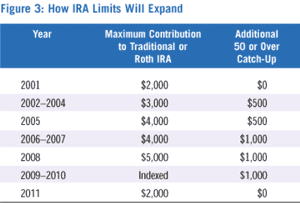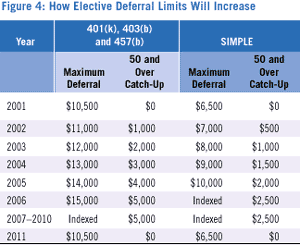| Retirement Savings Incentives |
|
The tax law expands opportunities available to most working people (and their spouses) to set aside tax-advantaged money for retirement. It also offers incentives to small companies to start retirement plans, and it allows more "portability" of benefits among plans as workers change jobs or shift career tracks.
IRA Provisions |
|

The AGI limits that apply to full Roth contributions ($150,000 joint; $95,000 single) and Roth conversions from Traditional IRAs ($100,000 joint or single) were not changed. Also unchanged are the AGI limits used to determine deductible contributions in Traditional IRAs.
Retirement Savings Plans
In several types of company plans, the law allows workers to "defer" salary into the plan up to annual limits. These include 401(k), 403(b), 457(b), and SIMPLE plans. Beginning in 2002, the limits will increase for each type of plan, and limits on 401(k), 403(b), and 457(b) plans will be synchronized. These three types of plans-which respectively cover workers in private corporations, non-profit institutions, and government entities-will begin to look alike in many respects. Rollovers will be allowed among them. Additional catch-up deferrals will be allowed for workers age 50 or over in each type of elective deferral plan, as shown in Figure 4.

Example: In 2006, a worker age 50 or over will be allowed to defer up to $20,000 into a 401(k), 403(b), or 457(b) plan. It's important to note that many plans impose their own limits on deferrals below the government limits.
New Rollover Features
The new legislation makes it even easier to manage retirement assets by permitting consolidation of different types of retirement plans. The following provisions are effective in 2002:
- Rollovers will be allowed among 401(k), 403(b) and 457(b) plans, in plans permitting such rollovers. Transfers or rollovers also can be made from these plans into Traditional IRAs.
- After-tax employee contributions can be included in a rollover to a qualified plan (or IRA), provided the plan allows and can separately account for after-tax contributions.
- Pre-tax IRA balances may be transferred to a qualified plan, if the plan allows.
Higher Limits for Company Plans
Beginning in 2002, companies will be able to make larger contributions to most types of retirement plans as dollar and percentage limits increase. These changes will allow companies to set aside more money for owners and older key employees.
Faster Vesting
In defined contribution plans, the company's contributions (and earnings on them) may vest on a delayed basis. Participants don't have a right to this money until completing a "years of service" requirement. However, starting in 2002, companies are required to offer faster vesting. This will give workers more job and career mobility without losing retirement plan benefits.
Incentives for Small Company Plans
Beginning in 2002, small companies with 100 or fewer employees may take a tax credit of up to $500 against qualified plan expenses in each of the first three years after starting a new plan.
The law simplifies the "top-heavy rules," which subject many small companies to complex requirements while making compliance with these rules more manageable.
"Government-Matching" Tax Credit
From 2002 through 2006, a tax credit will be available to individuals who put their own money into
retirement plans and have an AGI of $50,000 or less for joint filers or $25,000 or less for single filers.
Example: A single filer contributes $2,000 to a Roth IRA and has an AGI of $20,000. The credit will be calculated as 10% of $2,000-$200. Since credits reduce taxes dollar for dollar, this will be like getting $200 of "matching" from the government.
Planning Ideas for Retirement
Savings Incentives
Sock more money away: Now is the time to plan ahead for the higher contribution and deferral limits, especially if you are nearing retirement and can take advantage of the new "catch-up" contributions.
Alert children to the new tax credit: Encourage children who have joined the workforce to start a retirement plan savings habit early, especially if they can qualify for the new government- matching tax credit.
Pay attention to your retirement plan at work: A growing number of plans offer educational materials to participants. Read any material you receive about the changes your plan is making to comply with the new law. Don't be afraid to ask your financial professional or your tax adviser to review these materials with you.
Evaluate small-business incentives: Through this law, the federal government is encouraging small businesses to offer plans. If you own a small business, now is the time to talk to a financial professional about small-business retirement plan opportunities.